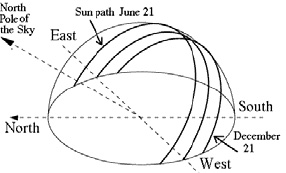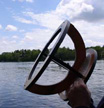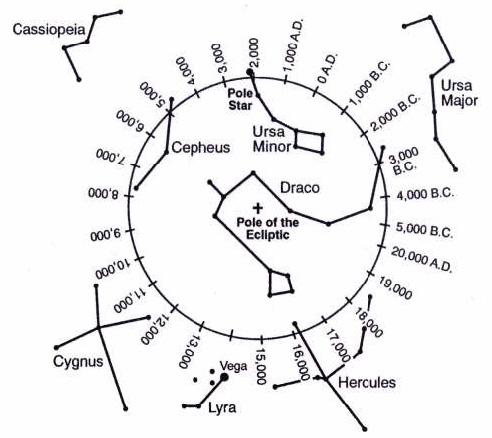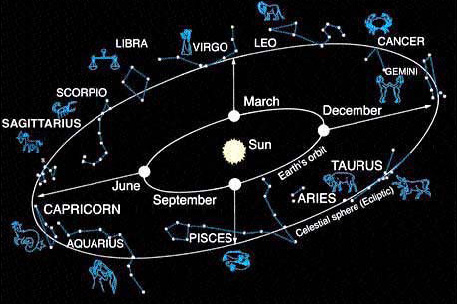Precession of the Equinox
The 26,000 year Calendar
 |
S.1 Introduction, and the basic Path of the Sun S.2 Axis Tilt and The Zodiac Movement S.3 The Night Path and Ancient Clocks S.4 Summary |
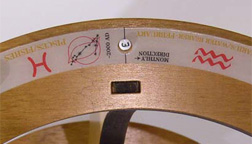 |
The Globe stand’s outer ring is meant to be a tool to understand the sky basics movements today and over thousands of years. |
What’s necessary to understand the star movements?
The knowledge of the unmoving location of the North Star is clearly vital in understanding the sky. What’s missing is the knowledge of the location and movement of the 12 Zodiac constellations. These constellations position the location of all the other stars (and the moon and planets).
Choose somewhere simple, close by, like your back yard. You will need to take several sightings during the day and night and if your really interested, throughout the year. Don’t try to get a perfect unobstructed view. Make it easy on yourself.
 |
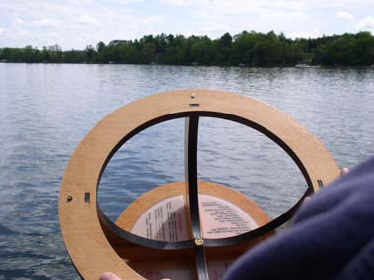 |
|
Compass – Find East
|
Stand – Point East. See North, South, West
|
A simple compass will do. The point on the horizon you see will always be due east if you stand in the same viewing place. You can use the globe stand base here to locate the other directions. Point the ″E″ markings to the east that you have found, and then the ″W″ to the west. The markings on the stand will show you now exactly where North and South are. Know these positions to make viewing easy from your chosen spot in the future. It’s necessary in new spots too. But you won’t need the stand in the future.
This is the only star that doesn’t move and will always be in the same place. It is the most important reference star. It is medium-bright, and easy to find using two different constellations the Big Dipper andLittle Dipper. Important: The North Star is also exactly the number of degrees above the North horizon as is your Latitude. The spinning axis of the earth points almost exactly at the North Star. If you were at the North Pole (at 090° N. Latitude), the star Polaris would be directly above you or 090° above the horizon. If you were on the equator with Latitude of 000° the North star would be zero degrees above the horizon (right on it). In the U.S. we live between 025° North Latitude in Florida to ~049° North Latitude by the Canadian border. You are somewhere in between. You can look up your Latitude on any decent road map or atlas. If you lived in Dayton Ohio at 040° North Latitude, the Pole star Polaris will be measured at 040° north of the horizon. If you are on a ship at sea with no clue as to your Latitude, find the North starPolaris and measure the number of degrees it lays north of the horizon. That then would be your latitude. It works both ways — know your latitude and find the star, or find the star and know your latitude.
| The North star is the last star in the tail of the Little Dipper. The Big Dipper is easier to locate since its stars are brighter. Using the Big Dipper, the two stars on the lip of the cup “point” to the North Star. |
|
Step 4. Everything Spins around the North Star
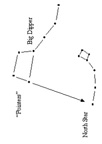 |
This is the same view but 6 hours later. The same pointing methods work to find the North Star. But now we can see that these constellations rotate around the pole star in a counter-clockwise direction. In fact all the stars in the sky rotate this way and hold their exact position too each other, but they rotate counterclockwise (when looking north). The stars in the far northern sky are nearly always visible so this pattern is easy to see. It is the stars that begin at one horizon and disappear at the other horizon that cause the most confusion. |
Step 5. The Earth Only Rotates
The stars are so far away that they don’t move relative to each other. Not in one lifetime. They are basically fixed spots. The only movement we perceive in one night is one thing — the rotation of the earth. The earth rotates on its axis once in every 24 hours. It rotates towards the east. We move, the stars don’t. As we rotate to the east, it appears the stars rotate around the North star beginning from the Eastern horizon and traveling to the Western horizon. There are 360° in a circle. In one hour the earth rotates 15° to the east and the stars appear to rotate 15° to the west. (360° ÷24 hours = 15°/hr) In 3 hours the stars will move 45° from one position to their next position. (15° x 3 hours = 45°) Predictable.
| We’ve been told the Sun rises in the East and sets in the West. Simply true but not very accurate nor helpful in finding stars. Only on two days of the year is this precisely true. Half of the year the sun rises north of east and sets north of west. The other half it risessouth of east and sets south of west. In the warm summer it rises north of east and gives us longer days. In the cold winter it rises south of east and is in the sky a shorter time. Its’ starting point changes every day. What is its path? One thing to know is that if the sun rises 10° North of due east one day it will set 10° North of due West that evening. The path the sun takes will shift throughout the year but will always be nearly parallel to all of its other paths. The path of the sun is known as the Ecliptic, but path of the sun is easier. Knowing the path of the sun during the day will help tell us the path of the stars that night, so it’s important. |
|
|
At this viewing location, the globe stand is used as a visual reference to approximate the path of the sun. East is across the lake. North is to the left. The sun rises and moves in an arc in a southward path until midday and then it appears to move back northward. This is what your sun path will do also. The sun does not start in the east and move in a path 90° to the horizon as is often believed. That path, once understood, will be easy to find any day, anywhere. |
Step 7. Precession of the Equinoxes
|
In the 12” Earth Perspective section we discussed that the Earth is tilted 23.5° to the plane of the sun. We also noted that it wobbles like a top on its axis and this is called precession. It takes the Earth ~25,920 years to complete one wobble of the top. | 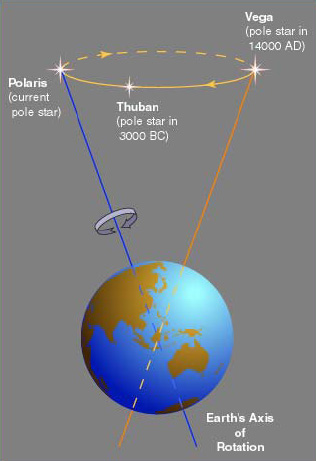 |
||
|
So while Polaris is currently our North Star it wasn’t always so. Thuban was the Pole star in 3000 BC and Vega will be in 14,000 AD. So we are off center. What is the exact center of the sky, called the Pole of the Ecliptic, directly above the Sun and Planets? The Center is in the middle of the Constellation Draco, the Dragon, and is the Pole of the Ecliptic. |
||||
|
The illustration shows where the Earths axis has pointed to and will point to in the future. Since having a Pole star is very helpful in navigation we are lucky to have had one during our formative era. The Earth rotates daily around Polaris, which is a little off center from the solar system pole, and we will see this effect in the location of the Zodiac constellations at night. |
Step 8. The Path of the Sun, Planets, and 12 Zodiac Constellations
Along that narrow path of the sun, that arc through the sky, all of the visible planets in the solar system will be found. The visible planets orbit the sun in a very narrow plane and they are on the solar path. Planets do move and so this does not predict where they will be on the path, but it significantly narrows the search. The moon has a uniquely strange orbit and swings from 5° above to 5° below the solar path. It can also be used at night to find the Zodiac stars.
The 12 Zodiac Constellations — immensely important throughout ancient history to now – also are located on this very narrow path between 8° above and 8° below the sun’s path. Knowing which Zodiac constellation will be visible at your viewing location helps understand the sky movements and find other constellations.
Step 9. The Four Most Important Dates in the Year
Much of history and religion are based on these dates and they are all connected to the Path of the Sun. The most important date is the first day of Spring – March 20th. On this date the sun rises exactly due east. As the summer progresses the Sun rises further north of east each day until it reaches its furthest rising point in the North. This is the first day of summer – June 21st. The sun then starts moving south in its rising point until it again rises due east at the first day of Autumn – September 22nd. It continues south until it reaches its furthest point south on the eastern horizon. This is the first day of winter – December 21st. Ancients tracked and marked the path of the sun throughout the year.
Step 10. Zodiac Positions and Movement

The 12 signs of the Zodiac travel in a connected circle around the earth and sun in the sky on the Sun’s path. Again, the suns path is usually called the ecliptic. If there were no sun and all was darkness, then, as the Earth rotated in 24 hours, each of the 12 Constellations would appear in the sky in ongoing sequential order, like a twelve horse merry-go-round. If we first saw the Constellation of Pisces it would then be followed by Aries and then Taurus etc. Each of these 12 constellations is about 30° long or 1/12th of the circle. It takes about 2 hours for each constellation to move through any point of the sky.
 |
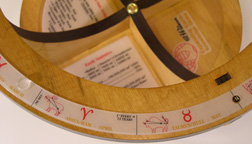 |
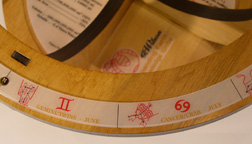 |
|
Aquarius/Pisces
|
Aries/Taurus
|
Gemini/Cancer
|
The outer ring of the Globe stand positions the twelve zodiac sequences accurately for reference. The three pictures above show segments of this ring. Within each segment there is 1) a star pattern representation, 2) a graphic, 3) the Latin and common name, 4) the standard symbol and 5) the month of appearance at dawn.
These are historic terms which indicate the sun is in the house of Pisces or that it rises in Pisces. The important date of March 20th is in play. On the dark evening of March 19th the zodiac constellations are moving through the sky. Two hours before dawn the Constellation Aquarius rises over the eastern horizon. Two hours later the first part of Pisces should appear. At that moment the sun rises and causes all the constellations to become invisible.
|
The constellations are all still there continuing their merry-go-round path but they are no longer visible during the bright daylight. Which Constellation was last visible just when dawn arose of the morning on March 20th, the first day of Spring? Pisces. And so we are in the age of Pisces, the Fishes. We will soon be going into the age of Aquarius. That will occur when the Sun rises in Aquariusduring dawn of a March 20th. These constellations shift position counterclockwise an almost imperceptible 1º, every 72 years. Not enough to effect our star viewing but every 2,160 years we move through 30° of sky and move to the next House (72 X 30 = 2160). The 2,160 years x 12 Constellations is ~25,920 years and is the same as the “25,920” year cycle necessary to complete the axis wobble. |
Step 12. Seasonal Zodiac Paths
The Sun’s path is always a smooth continuous arc. Now that we know where it is, it would be nice if the nighttime zodiac stars would appear on this exact path of the sun found during the day. That would make it easy. But not true. However, it’s not difficult once you know what happens.
Because of the Earths 23.5° degree tilt we get the seasons. In the summer (longest day June 21st) the sun is highest in the sky. On this day, as the earth rotates into night, the northern hemisphere will see the zodiac constellations (now opposite the sun) at their lowest position in the sky arc. In the winter (shortest day Dec. 21st) the sun travels its lowest arc during the day. At night, the zodiac constellations will trace the suns high path taken in the summer. During the autumn and spring where the day and night is of equal length and the sun rises due east, so will rise the zodiac constellations rise due east. So the night skymirrors the arc of the sun. If the sun rises 5° south of east, the zodiac constellations will rise ~ 5° north of east. If the sun rises 30° north of east, the constellations will rise ~ 30° south of east.
Table 4. Seasonal Sun Paths in Relation to Zodiac
| Summer | The Sun Path is higher in the sky during the day and the Zodiac islower in the sky at night |
| Autumn | The Sun Path is medium height in the sky during the day and the Zodiac is similar. |
| Winter | The Sun Path is lower during the day and the Zodiac is higher in the sky at night. |
| Spring | The Sun Path is medium height in the sky during the day and the Zodiac is similar. |
Find the Sun’s path during the day. The “merry go round” of the planets, zodiac and moon’s path at night will be a narrow arc also. Find the night path, and use it to find the visible constellations.
 |
The outer ring has the Zodiac signs on it and four holes to position it on the N, E, S, and W markers. The instructions on the globe base indicate that on the first day of spring Pisces should be placed on the East marker. 1st day of summer would place Pisces on the South marker. The 1st day of Fall place Pisces on the West marker, and the first day of winter Pisces would be placed North. For months in between use an approximation. While Pisces will be placed on different directions on the ring it is the constellation starting in the East at that determines the Constellation of the month. Let’s start with Pisces in the East. |
When the sun rises it blocks out the constellations that would be visible except for the daylight. In this case Pisces follows the Sun but is not visible. Rotate the stand to follow the Path of the sun until the East marker sets at night in the west. That will show the Zodiac constellations positions at dusk. Pisces will be partially visible as the sun goes down but the following constellations — Aries, Taurus, Gemini, and Cancer — will be more visible. Likely only 3 or 4 Zodiac constellations out of 12 will be visible in any season before midnight when most people will be viewing. That’s why you can’t see them all. The rest are below the horizon.
Experiment with the Pisces position, rotating the stand 180 degrees from the East to West position to represent their movement during the day hours. The Constellation 2 to 3 back will be the most visible in early evening.
Table 5. Seasonal Zodiac Constellation Positions
| Season |
Pisces Ring Position
|
Zodiac Constellation at Dawn
|
Next Constellations in Sequence
|
|||||
| Spring | East | Pisces | Leo | Cancer | Gemini | Taurus | Aries | Pisces |
| Summer | South | Gemini | Scorpius | Libra | Virgo | Leo | Cancer | Gemini |
| Autumn | West | Virgo | Aquarius | Capricorn | Sagittarius | Scorpius | Libra | Virgo |
| Winter | North | Sagitaurius | Taurus | Aries | Pisces | Aquarius | Capricorn | Sagittarius |
|
Bold = Having bright stars and easy visibility. Others are dimmer.
|
||||||||
Step 14. Precession and the Ancient Calendar
Picture the movement of the solar system as a giant and accurate time telling machine. Before clocks it was exactly that. Knowing the Zodiac position during any ancient season, tells us how long ago an event took place. That is if we are given the season and the zodiac position. There is evidence that ancients left us such calendars of their time so it is valuable in knowing how to read this clock. In Step 10, the wobble of the earth was discussed. It has also been shown that 25, 920 years is needed to make a full cycle. Let’s see how this works and how the globe stand helps explain it.
There are 12 zodiac constellations and they encompass 360°. Therefore each constellation is about 30° long. During any day the Zodiac constellations rotate in an apparent clockwise direction when facing south. Then because of the Earth’s revolution around the sun the Zodiac Constellations ratchet forward 1° each day. And so while Pisces just begins in the Eastern horizon on the first day of spring, 30 days later it will just be leaving that eastern position to be replaced by the next constellation which is Aries.
Over long periods of time however, due to the wobble another action takes place. Every 72 years, or so, like a giant gear, the zodiac positions ratchet backwards 1° (counterclockwise). This is happening slowly and continuously, but the effect is 1° every 72 years. 30° size of the constellation multiplied by 72 years (30 x 72 = 2160) equals 2,160 years it takes for a zodiac sign to start and end “an age”. 12 constellations (12 x 2,160 = 25,920) give a full cycle of 25,920 years. That’s our clock. Let’s see how it works. Remember, the starting point is the first day of spring when the sun is exactly on the eastern horizon. Today, Piscesdominates. But in about 2° or 150 years, the constellation of Aquarius will move counterclockwise back into being rising at dawn on the first day of spring.
If we went back in time 2,160 years we would rotate the ring clockwise and see that Aries the Ram was the significant Zodiac sign. It is not just religious coincidence that during the last 2000 years of the Christian era, loaves and fishes, were mentioned. Before that the symbolism of Ram sacrifice was predominant.
Most archeologists are not familiar with dating by these methods. There are no simple tools available except for complicated computer programs. This globe stand can provide tools to understand near term star movements and long term precessional cycles.



